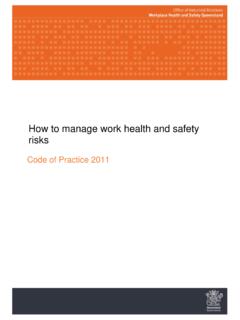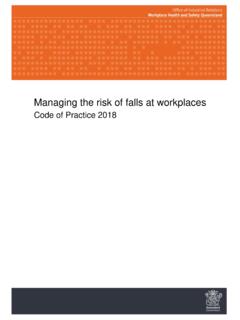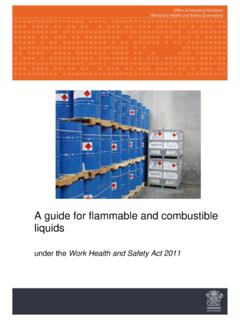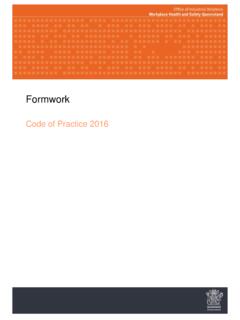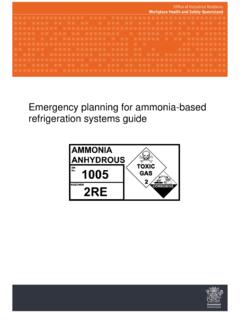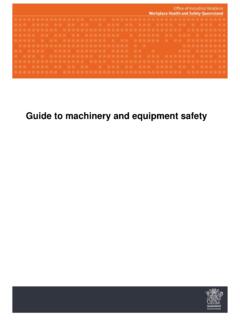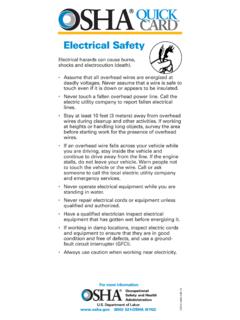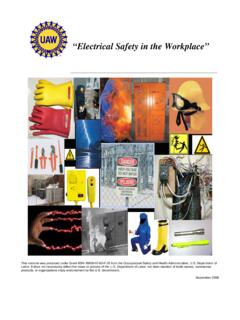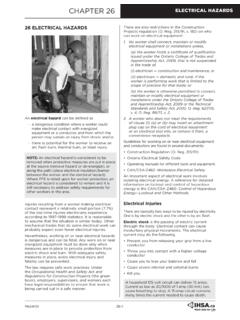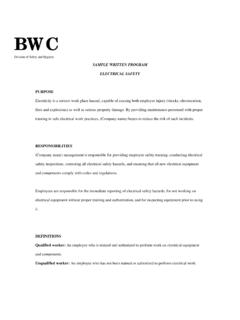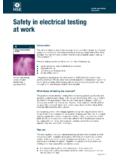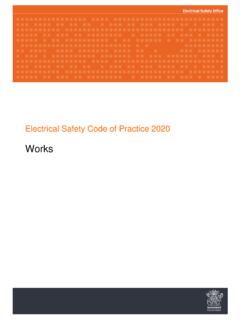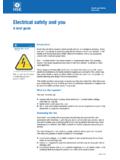Transcription of Managing electrical risks in the workplace Code of ...
1 Managing electrical risks in the workplace Code of Practice 2021 Managing electrical risks in the workplace Code of practice 2021 Page 2 of 60 PN12643 ISBN Creative Commons This copyright work is licensed under a Creative Commons Attribution-Noncommercial International licence. To view a copy of this licence, visit In essence, you are f ree to copy, communicate and adapt the work f or non-commercial purposes, as long as you attribute the work to Saf e Work Australia and abide by the other licence terms. Managing electrical risks in the workplace Code of practice 2021 Page 3 of 60 Table of contents Legislative Foreword ..5 1. Introduction ..7 What are electrical risks ?
2 7 What is electrical work? .. 7 Who must manage electrical risks ? .. 8 What is involved in Managing electrical risks at the workplace ? .. 11 2. The risk management process .. 13 Identifying the 13 Assessing the 14 Controlling the risks .. 15 Maintaining and reviewing control measures .. 16 3. Specific hazards and control measures .. 18 Unsafe electrical equipment and electrical installations at the 18 Inspecting and testing electrical equipment .. 19 safety switches .. 20 4. Working 25 General principles verification of de-energised electrical equipment .. 25 Work on cables (including cutting cables) .. 26 5. Isolation, locking off and access .. 27 Securing the 27 Tagging systems .. 30 Altering isolation for testing, fault finding and re-energising.
3 32 Restoring power .. 32 Leaving unfinished work .. 32 6. Energised electrical work .. 33 Prohibition on energised electrical work .. 33 Planning and preparation .. 34 Carrying out energised electrical work .. 35 Particular energised electrical work testing and fault 39 7. Working near energised electrical 40 Planning and preparation .. 40 Carrying out work near energised electrical parts .. 40 8. Tools and equipment .. 42 Maintenance and inspection .. 42 Ladders, scaffolds and similar equipment .. 42 Managing electrical risks in the workplace Code of practice 2021 Page 4 of 60 Insulating barriers and insulating 43 Test instruments .. 43 Personal protective equipment .. 44 9. High voltage electrical 46 Additional risks associated with high voltage.
4 46 Planning for high voltage installation work .. 46 Appendix A Glossary .. 47 Appendix B Advantages and disadvantages of non-portable and portable safety 50 Non-portable safety switches .. 50 Non-portable safety switches installed at the main switchboard .. 50 Non-portable safety switches installed at a socket outlet .. 50 Portable safety switches .. 51 Portable safety switches portable plug 51 Portable safety switches portable stand-alone unit .. 51 Appendix C risks associated with electrical work .. 53 Appendix D Preventative actions checklist .. 59 Managing electrical risks in the workplace Code of practice 2021 Page 5 of 60 Legislative framework The electrical safety Act 2002 (the ES Act) is directed at eliminating the human cost to individuals, families and the community of death, injury and destruction that can be caused by electricity.
5 The ES Act establishes a legislative framework for preventing persons from being killed or injured by electricity, and preventing property from being destroyed or damaged by electricity. The ES Act places the primary electrical safety duty on a person conducting a business or undertaking, who must ensure the business or undertaking is conducted in a way that is electrically safe. Duties are also placed on officers of a person conducting a business or undertaking, workers and other persons at a workplace , as well as electricity entities, designers, manufacturers, importers, suppliers, installers, repairers and persons in control of electrical equipment. The Work Health and safety Act 2011 (WHS Act) requires persons who have a duty to ensure health and safety to manage risks by eliminating health and safety risks so far as is reasonably practicable, and if it is not reasonably practicable to do so, to minimise those risks so far as is reasonably practicable.
6 The WHS Act provides a framework to protect the health, safety and welfare of all workers at work. It also protects the health and safety of all other people who might be affected by the work. The WHS Act places the primary health and safety duty on a person conducting a business or undertaking, who must ensure, so far as is reasonably practicable, the health and safety of workers at the workplace . Duties are also placed on officers of a person conducting a business or undertaking, workers and other persons at a workplace . In terms of electrical safety , where the ES Act and the WHS Act both apply, the ES Act takes precedence. Foreword This Code of Practice on how to manage electrical risks in workplaces is made under section 44 of the ES Act. A code of practice is a practical guide to achieving the standards of electrical safety required under the ES Act and the electrical safety Regulation 2013 (the ES Regulation).
7 A code of practice applies to anyone who has an electrical safety duty in the circumstances described in the code. In most cases, following a code of practice would achieve compliance with the electrical safety duties in the ES Act, in relation to the subject matter of the code. Like regulations, codes of practice deal with particular issues and do not cover all hazards or risks that may arise. Health and safety and electrical safety duties require duty holders to consider all risks associated with work, not only those for which regulations and codes of practice exist. Codes of practice are admissible in court proceedings under the ES Act and ES Regulation. Courts may regard a code of practice as evidence of what is known about a hazard, risk or control and may rely on the code in determining what is reasonably practicable in the circumstances to which the code relates.
8 Compliance with the ES Act and ES Regulation may be achieved by following another method, such as a technical or an industry standard, if it provides an equivalent or higher standard of electrical safety than the code. An inspector may refer to a code of practice when issuing an improvement or electrical safety protection notice. This Code of Practice is based on the model code of practice of the same name developed by Safe Work Australia under the Council of Australian Governments Inter-Governmental Agreement for Regulatory and Operational Reform in Occupational Health and safety for adoption by the Commonwealth, state and territory governments. Scope and application This Code is intended to be read by a person conducting a business or undertaking (PCBU).
9 It provides practical guidance to PCBUs on Managing electrical risks in the workplace . It applies to all workplaces where a PCBU: has management or control of electrical equipment, including electrical installations carries out electrical work on or near energised electrical equipment, including electrical installations. Managing electrical risks in the workplace Code of practice 2021 Page 6 of 60 This Code does not apply to: electrical work on extra-low voltage electrical equipment, including extra-low voltage electrical installations electrical work on high voltage equipment after switching, isolation, short circuiting and earthing, subject to summary guidance in Chapter 9 of this Code the manufacture of electrical equipment automotive electrical work work that is not electrical work carried out on telephone, communication and data systems repair of consumer electrical equipment when unplugged from any electrical socket outlet.
10 Extra-low voltage means voltage that does not exceed 50 volts alternating current (50 V ) or 120 volts ripple-free direct current (120 V ripple free ). How to use this Code of Practice This Code should be read in conjunction with the ES Act, the ES Regulation, the WHS Act, the Work Health and safety Regulation 2011 (the WHS Regulation) and other relevant codes of practice. In providing guidance, the word should is used in this Code to indicate a recommended course of action, while may is used to indicate an optional course of action. The terms health and safety and work health and safety are used in this Code to indicate a wider application than just electrical safety . However, electrical safety should be taken as being included when the terms health and safety and work health and safety are used.
